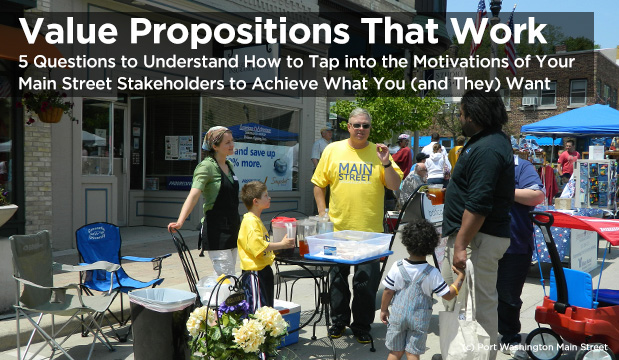Main Spotlight: Connecting, Innovating, and Sustaining a Healthy Main Street Movement
Key takeaways from six sessions at the 2025 Main Street Now Conference.

Marion, Iowa © Tasha Sams
We work in collaboration with thousands of local partners and grassroots leaders across the nation who share our commitment to advancing shared prosperity, creating resilient economies, and improving quality of life.

Emporia, Kansas © Emporia Main Street
Made up of small towns, mid-sized communities, and urban commercial districts, the thousands of organizations, individuals, volunteers, and local leaders that make up Main Street America™ represent the broad diversity that makes this country so unique.

Chicago, Illinois © Main Street America
Looking for strategies and tools to support you in your work? Delve into the Main Street Resource Center and explore a wide range of resources including our extensive Knowledge Hub, professional development opportunities, field service offerings, advocacy support, and more!

Waterloo, Iowa © Main Street Waterloo
Your one-stop-shop for all the latest stories, news, events, and opportunities – including grants and funding programs – across Main Street.

Kendall Whittier — Tulsa, Oklahoma © Kendall Whittier Main Street
Join us in our work to advance shared prosperity, create strong economies, and improve quality of life in downtowns and neighborhood commercial districts.

A well-defined problem is half solved, but motivating someone to take the appropriate action that solves the problem can sometimes be the most confounding part of any conversation.
Enter the world of the value proposition. "Here is why you should do [x]" seems easy and logical from your perspective. The truth is, there is some inertia that needs to be generated and obstacles to overcome in order to build a value proposition that people will respond to.
Think about a time when you walked into one of your local businesses to just touch base and say hello. You started with a simple question to the owner, "How is everything going? Business good?"
They replied, " I expected that by being located on Main Street, I would have a lot more business." You may have been thinking in your head a lot of different ways to respond to that statement. Like how the front of their business isn't really inviting. That perhaps when you walked in you weren't greeted in a way that made you feel welcome. Or perhaps that their employees appeared pretty non-responsive and disinterested. But your internal editor did you a service and you bit your tongue.
It's easy for us to stand on the outside and see the gaps a business may have, but the key is in how we share that information so that they feel like you are on their side and that you're there to help. That the services you provide are critical to them getting what they want.
You Wear 101 Hats
Main Street Program Managers have a wide variety of stakeholders that they report to, depend upon and serve ranging from municipalities, government officials, local residents, business owners, volunteers, visitors and donors. Each of them has unique motivations, expectations, and objectives, so your ability to quickly change hats and adapt your communication becomes critical to your success.
The solution to motivating people to take an action is really quite simple in concept, easy to learn and quick to implement. The following technique is one that I use to accomplish the following:
• Build rapport, relationship & trust
• Nurture prospects
• Close sales
• Conflict resolution
• Customer recovery
• Reconnect with an old customer
• Find action takers
• Motivate influencers to find more people
Because regardless of what people do, or their relationship to you (personal or professional) we are all motivated by the answer to one simple question:
"What's in it for me?"

In marketing parlance this is defined by the acronym WIIFM (pronounced wiff-em).
Knowing the answer to the question, WIIFM, provides the most critical pieces of information you need to construct a powerful value proposition that gets people nodding their heads, "Yes!" In the absence of this information you'll end up doing it one of two ways: 1) Guessing or 2) Being bossy and directive. Both of these approaches greatly reduces your odds of success.
You must lead them to a place where they share what they want and what they're willing to do to get it.
Motivation theory is a lot like the hub of a wheel. Everything stems from the hub and once you understand what will compel someone to take action, then you can easily design your solution to match their motivations. When you discover the answer to the WIIFM question that everyone is asking in their mind, then you'll know exactly what the next step is.
To successfully design a value proposition, it takes some conversational engineering with a tincture of psychology. We call this the Curiosity Dialogue. Being Curious
There are three things required in order to pull off this conversation. 1) Natural curiosity, 2) Be fully present in the conversation. Listen to understand, not to reply and 3) Be authentic so that the person you're talking to sees that you're sincere and earnest. Because no one likes to be in a conversation where they feel like they're being interrogated. It has to have an ease to it. Practice this at home with your loved ones, your family, next time you're socializing, even your pets.

1. What's going on now? This is the icebreaker and establishes the present state. When we meet someone for the first time, it establishes rapport. When we reconnect with someone we already know, it quickly brings us up to speed.
For example:
a. With a prospect who is considering joining our Main Street membership we might ask, "How is your business going? Are you seeing sales growth?"
b. With a donor we might say, "Thank you so much for the gift of [x] dollars. I'm curious, what is it about our mission that stuck a chord with you?"
c. With a government official, "What are your beliefs around downtown revitalization and supporting independent business owners?"
2. Where would you rather be? How would you like things to look? What does the ideal look like? This establishes the future state. The vision. If we could wave our magic wand, what would make them happy? This is an important question because it helps us as service providers understand whether we have a solution that will help them.
For example:
a. With a prospect it might sound like this, "Are you open to sharing with me what you would like your business to look like in one year?"
b. With a donor it might be, "Would you like to be able to contribute more to the revitalization of our downtown area so that we can bring more visitors to our area?"
c. With a government official, "What do you want downtown to look like for your grandchildren? "
3. How will it feel when they have achieved this future state?
Because about 80% of our 'buying' decisions are rooted in emotions, this is a critically important question that reveals their emotional triggers. Emotional triggers are words we use to describe our feelings. As they are telling you how having this will feel, listen carefully to their word choices and store these words for future use. We'll use their word choices when we're asking them to take action. We use their words to describe what we do and how what we provide will help them get the result they want.
For example:
a. With a prospect, "How amazing will that feel when your business is there!?!"
b. With a donor, "Why is contributing time or money to our downtown important to you?"
c. With a government official, "How will it feel for you to know that you participated in creating that sense of community pride and involvement?"
4. What's preventing you from having that outcome now? What are the obstacles? Where are the barriers? The answers revealed here help you understand what they perceive are preventing the desired results. How we use this information is in the close when we're asking them to take an action. We can build our solution around their perceived challenges and take away their pain.
For example:
a. With a prospect, "Why do you think you don't have that level of business now? What do you believe is the biggest challenge to making that happen?"
b. With a donor, "What is preventing you from donating $20 a month to support our revitalization efforts?"
c. With a government official, "Where do you see the greatest obstacles to making our downtown area exactly the place you visualize?"
5. How serious are you? This is the kicker question because the answer tells you whether they are action takers, or if they are just venting and have no intention of making any changes in their present state. Often times we hear people talk about things they want, but they have no intention of doing anything other than complaining or dreaming. We want to let everyone self sort, and this question helps them do exactly that. Remember, we want to invest our time and energy with people who are willing to do what it takes.
The secret to a compelling value proposition is to first gather information so that you're positioning the proposition around what they care and value, their vision, their dreams, with an eye towards taking away their pain points and providing real results. The transition statement looks a bit like this:
"I think I have something that can help you get that."
The best part about this simple conversation is that it doesn't put you in a position of judgment. It's simply designed to understand how to best support all the different stakeholders in your stable in a way that gets them the results they're telling you they want.
Pamela Herrmann is a best-selling author, speaker and resultant on the subject of Exceptional Customer Experiences. Subscribe today to her podcast, Customers For Life, available on iTunes and Soundcloud for more tips and strategies.